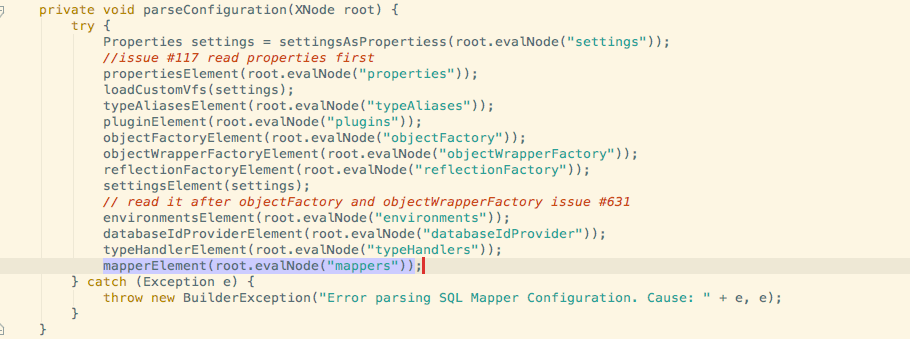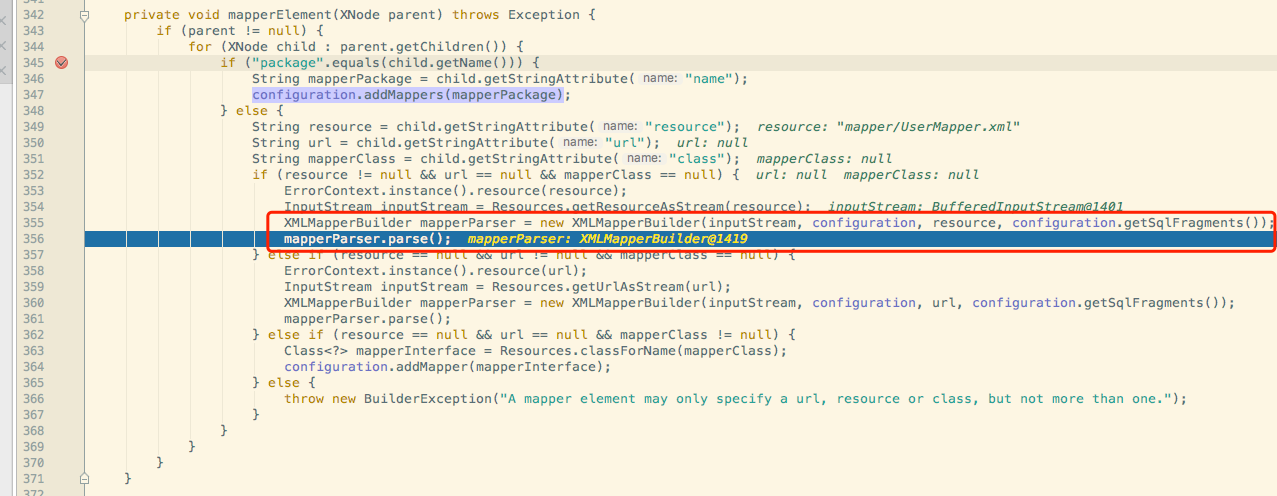MyBatis 学习记录2 Mapper对象是如何生成的
主题
以前我一直有一个问题不懂.并且觉得很神奇.就是Mybatis我们开发的时候只需要定义接口,并没有写实现类,为什么我们运行的时候就可以直接使用? 现在我想分享下这部分大致是怎么实现的.
在启动的时候

根据之前的分享,在初始化阶段Build SqlSessionFactory的时候需要用到XMLConfigBuilder去parse XML文件生成Configuration对象,在 parse的步骤中其中有一步就是parse mappers节点


在parse mapper过程中会用到XMLMapperBuilder去parse.一步一步进入断点.

会发现后面会调用configuration的addMapper方法.它会调用MapperRegistry的addMapper方法

MapperRegistry相当用knownMappers这个hashmap于为每个Mapper注册一次,其中key是你自定义的Mapper接口的class,Value是MapperProxyFactory类的对象.
Factory一个就是一个工厂类,它肯定需要生产对应的对象,从名字上也能发现它生产的就是MapperProxy
- /**
- * Copyright 2009-2015 the original author or authors.
- * <p>
- * Licensed under the Apache License, Version 2.0 (the "License");
- * you may not use this file except in compliance with the License.
- * You may obtain a copy of the License at
- * <p>
- * http://www.apache.org/licenses/LICENSE-2.0
- * <p>
- * Unless required by applicable law or agreed to in writing, software
- * distributed under the License is distributed on an "AS IS" BASIS,
- * WITHOUT WARRANTIES OR CONDITIONS OF ANY KIND, either express or implied.
- * See the License for the specific language governing permissions and
- * limitations under the License.
- */
- package org.apache.ibatis.binding;
- import org.apache.ibatis.session.SqlSession;
- import java.lang.reflect.Method;
- import java.lang.reflect.Proxy;
- import java.util.Map;
- import java.util.concurrent.ConcurrentHashMap;
- /**
- * @author Lasse Voss
- */
- public class MapperProxyFactory<T> {
- private final Class<T> mapperInterface;
- private final Map<Method, MapperMethod> methodCache = new ConcurrentHashMap<Method, MapperMethod>();
- public MapperProxyFactory(Class<T> mapperInterface) {
- this.mapperInterface = mapperInterface;
- }
- public Class<T> getMapperInterface() {
- return mapperInterface;
- }
- public Map<Method, MapperMethod> getMethodCache() {
- return methodCache;
- }
- @SuppressWarnings("unchecked")
- protected T newInstance(MapperProxy<T> mapperProxy) {
- return (T) Proxy.newProxyInstance(mapperInterface.getClassLoader(), new Class[]{mapperInterface}, mapperProxy);
- }
- public T newInstance(SqlSession sqlSession) {
- final MapperProxy<T> mapperProxy = new MapperProxy<T>(sqlSession, mapperInterface, methodCache);
- return newInstance(mapperProxy);
- }
- }
- /**
- * Copyright 2009-2015 the original author or authors.
- * <p>
- * Licensed under the Apache License, Version 2.0 (the "License");
- * you may not use this file except in compliance with the License.
- * You may obtain a copy of the License at
- * <p>
- * http://www.apache.org/licenses/LICENSE-2.0
- * <p>
- * Unless required by applicable law or agreed to in writing, software
- * distributed under the License is distributed on an "AS IS" BASIS,
- * WITHOUT WARRANTIES OR CONDITIONS OF ANY KIND, either express or implied.
- * See the License for the specific language governing permissions and
- * limitations under the License.
- */
- package org.apache.ibatis.binding;
- import org.apache.ibatis.reflection.ExceptionUtil;
- import org.apache.ibatis.session.SqlSession;
- import java.io.Serializable;
- import java.lang.reflect.InvocationHandler;
- import java.lang.reflect.Method;
- import java.util.Map;
- /**
- * @author Clinton Begin
- * @author Eduardo Macarron
- */
- public class MapperProxy<T> implements InvocationHandler, Serializable {
- private static final long serialVersionUID = -6424540398559729838L;
- private final SqlSession sqlSession;
- private final Class<T> mapperInterface;
- private final Map<Method, MapperMethod> methodCache;
- public MapperProxy(SqlSession sqlSession, Class<T> mapperInterface, Map<Method, MapperMethod> methodCache) {
- this.sqlSession = sqlSession;
- this.mapperInterface = mapperInterface;
- this.methodCache = methodCache;
- }
- @Override
- public Object invoke(Object proxy, Method method, Object[] args) throws Throwable {
- if (Object.class.equals(method.getDeclaringClass())) {
- try {
- return method.invoke(this, args);
- } catch (Throwable t) {
- throw ExceptionUtil.unwrapThrowable(t);
- }
- }
- final MapperMethod mapperMethod = cachedMapperMethod(method);
- return mapperMethod.execute(sqlSession, args);
- }
- private MapperMethod cachedMapperMethod(Method method) {
- MapperMethod mapperMethod = methodCache.get(method);
- if (mapperMethod == null) {
- mapperMethod = new MapperMethod(mapperInterface, method, sqlSession.getConfiguration());
- methodCache.put(method, mapperMethod);
- }
- return mapperMethod;
- }
- }
从代码中我们可以得知,这里是用了JDK动态代理,MapperProxy类implements了InvocationHandler,
如果是调用自定义Mapper的Object类中的方法,比如toString,那就直接调用,否则的话调用mapperMethod.execute去执行对应的方法(比如selectById).那么mapperMethod是什么呢?
这个类的对象其实就是对应你写的Mapper里的方法,你的每个方法对应1个MapperMethod,相当于是Java的Method的包装.
另外还包含了你在XML里定义的SQL字符串, 是select还是insert还是update,delete操作等信息.相当于融合了你定义的Mapper里的Method和你为每个Method在XML里的写的信息.
这样你调用mapperMethod.execute的时候就能找到对应的SQL去执行了.
通过SqlSession获取Mapper
初始化完成后就如同之前的介绍,会在confuguration的mapperRegistry里注册好了各种MapperFactory.那么通过SqlSession去获取Mapper的时候也是类似的.会调用configuration去获取Mapper,内部会调用mapperRegistry去获取Mapper


然后通过MapperProxyFactory去创建一个MapperProxy并返还


小结
1.说白了,其实就是利用JDK动态代理,返回给你1个实现了你写的Mapper接口的对象,而其中的Invocation接口的实现类就是MapperProxy.
2.在初始化阶段会为你写的每个Mapper在Configuration的MapperRegistry里注册一个MapperFactory,当你要获取Mapper实例的时候就通过这个Factory来new.
3.当你调用Mapper.XXX方法的时候,比如select,就会调用MapperProxy的invoke方法,获取你定义在Mapper里的xxx方法对应的MapperMethod对象,这个对象就是Method的封装,同时在XML里找到对应的select语句再执行.
4.你写的每个Mapper类的对象对应1个MapperProxyFactory生成1个MapperProxy,你在Mapper中定义的每个方法对应1个MapperMethod,它是Java的Method的封装
MyBatis 学习记录2 Mapper对象是如何生成的的更多相关文章
- MyBatis 学习记录5 MyBatis的二级缓存
主题 之前学习了一下MyBatis的一级缓存,主要涉及到BaseExecutor这个类. 现在准备学习记录下MyBatis二级缓存. 配置二级缓存与初始化发生的事情 首先二级缓存默认是不开启的,需要自 ...
- MyBatis 学习记录3 MapperMethod类
主题 之前学习了一下MapperProxy的生产过程,自定义Mapper类的对象是通过动态代理生产的,调用自定义方法的时候实际上是调用了MapperMethod的execute方法:mapperMet ...
- mybatis 学习记录1
起因 以前刚学习java三大框架的时候持久层框架我是自学的是hibernate..感觉蛮好用的,so easy..后来大三实习公司用的是jpa(hibernate外包装一层)...再后来工作1年多用的 ...
- MyBatis 学习记录7 一个Bug引发的思考
主题 这次学习MyBatis的主题我想记录一个使用起来可能会遇到,但是没有经验的话很不好解决的BUG,在特定情况下很容易发生. 异常 java.lang.IllegalArgumentExceptio ...
- MyBatis 学习记录6 TypeHandler
主题 因为对MyBatis在JDBC数据和Java对象之间数据转化比较感兴趣,所以就记录并学习一下TypeHandler. 使用场景 如上图所示,观察下接口方法就能明白.TypeHandler主要用于 ...
- MyBatis 学习记录4 MyBatis的一级缓存
主题 分享记录一下MyBatis的一级缓存相关的学习. Demo public static void firstLevelCache() { init("mybatis-config.xm ...
- mybatis学习记录六——一对一、一对多和多对多查询
9 订单商品数据模型 9.1 数据模型分析思路 1.每张表记录的数据内容 分模块对每张表记录的内容进行熟悉,相当 于你学习系统 需求(功能)的过程. 2.每张表重要的字段设置 非空 ...
- Mybatis学习记录(六)----Mybatis的高级映射
1.一对多查询 1.1 需求 查询订单及订单明细的信息. 1.2 sql语句 确定主查询表:订单表 确定关联查询表:订单明细表 在一对一查询基础上添加订单明细表关联即可. SELECT orders. ...
- Mybatis学习记录(五)----Mybatis的动态SQL
1. 什么是动态sql mybatis核心 对sql语句进行灵活操作,通过表达式进行判断,对sql进行灵活拼接.组装. 1.1 需求 用户信息综合查询列表和用户信息查询列表总数这两个statemen ...
随机推荐
- 在制作跨平台的 NuGet 工具包时,如何将工具(exe/dll)的所有依赖一并放入包中
NuGet 提供了工具类型的包支持,生成一个基于 .NET Core 的 dll 或者基于 .NET Framework 的 exe 之后,你几乎可以对项目做任何事情.但是,默认情况下,NuGet 不 ...
- vector 介绍
介绍 这篇文章的目的是为了介绍std::vector,如何恰当地使用它们的成员函数等操作.本文中还讨论了条件函数和函数指针在迭代算法中使用,如在remove_if()和for_each()中的使用.通 ...
- 《DSP using MATLAB》示例Example 8.29
%% ------------------------------------------------------------------------ %% Output Info about thi ...
- test20181029 思考熊的马拉松
题意 思考熊的马拉松 问题描述 今年,n只思考熊参加了校园马拉松比赛.马拉松的赛道是环形的,每圈的长度是A,完成比赛需要跑L圈. 比赛中,甲领先乙很长距离,绕过一圈或多圈后从后面追上了乙的现象叫做&q ...
- chrome安装vue-devtools
安装方法1: 需正常打开chrome商店,搜索vuejs devtools 安装.chrome://extensions/ 开发者工具-扩展程序下启用: 方法2: github下载插件,npm包安装依 ...
- ffmpeg hls 点播负载均衡简单实现
备注: 主要是进行文件的切片处理,以及m3u8 的文件前缀添加以达到通过nginx 或者类似的分布式文件工具进行数据切片处理 参考配置如下: ffmpeg -y -i mydemo.mp4 -vcod ...
- struts 2整合spring要注意的问题(二)
在 struts2_spring_plugin.xml配置文件里有一个strus.objectFactory.spring.autoWire 属性 默认值为name 也就是说你不想装载.它都会找个 ...
- oracle之 RAC Interconnect之HAIP
0. 背景 Oracle 从11.2.0.2开始引入了一个新特性叫做Redundant Interconnect,简称HAIP.HAIP的目的用来代替操作系统级别的网卡绑定以实现Active-Acti ...
- 生产环境LNMP (交友)
一. 下载一键安装包 LNMP 官方地址为:http://lnmp.org/ 原生产环境为 : php5.4.32 mysql 5.5 nginx 1.40 我们用LNMP包安装相应的环境 ...
- (转)Inno Setup入门(八)——有选择性的安装文件
本文转载自:http://blog.csdn.net/yushanddddfenghailin/article/details/17250827 这主要使用[Components]段实现,一个演示的代 ...
